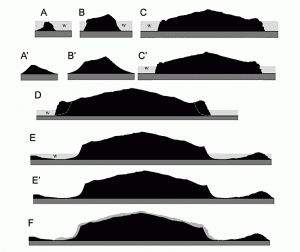Two features of Olympus Mons have puzzled geologists since they were discovered decades ago. First are the “aureole” deposits, rough terrain extending as much as 400 kilometers (250 miles) from the volcano. And second is the scarp, about 8,000 meters (26,000 feet) high that surrounds the entire structure at the foot of the mountain.

WET FEET? The cliff at the base of Olympus Mons (seen here in cartoon form) resulted from lava flows being abruptly cooled by water as they reached the foot of the growing volcano. The chilled lava piled up, making a steep, unstable slope, which then collapsed in landslides. (Image taken from Figure 4 in the paper.)
A new paper in Planetary and Space Science by Fabio De Blasio (Sapienza University of Rome) suggests that both are the result of Olympus Mons being surrounded by an ocean for most of the time that repeated lava eruptions were building the volcano.
Olympus Mons is the largest volcano in the solar system, standing about 21 km (14 mi) higher than the plain around it. The volcano spreads 600 km (370 mi) wide, enough to cover the state of Arizona.
De Blasio writes, “Numerical simulations and a comparative study of similar volcanic structures on Earth suggest that a volcanic edifice with the characteristics of Olympus Mons cannot be formed without the presence of water at the base.”
The reason, he says, is that the highly fluid lavas erupted by Olympus Mons would have cooled slowly and produced gentle slopes (less than 1° to 5°) all the way down to the level of the surface surrounding the volcano. Instead, those slopes end at the boundary scarp, where they abruptly steepen to 12° to 15°, in places reaching 28°.
The solution is a body of water around the volcano, he explains. Water cools lava nearly a thousand times faster than air. The abrupt cooling where the lava touches the water creates a steep edge. As continuing lava flows pile up where they cool quickest, the edge becomes unstable and prone to collapse.
The water hypothesis also fits other evidence, De Blasio says. “There has been much interest in the last decades for the possible presence of an ancient ocean in the northern basin.” This has been called Oceanus Borealis, and scientists have estimated it was Noachian to Hesperian in age, roughly contemporaneous with the growth of Olympus Mons.
“Some interpretations have suggested the ocean would affect the Olympus Mons area,” he notes.
The water, De Blasio stresses, did not have to be as deep as the scarp is high. The scarp is what was left after gigantic landslides tore away the steep edge of the volcano. And with friction decreased by the water, the slide debris fanned out to form the aureole deposits.
Similar features, De Blasio notes, surround the Hawaiian Islands, where the Big Island is the one structure on Earth closest in size to Olympus Mons.









Pingback: More evidence for ancient ocean on Mars | Alkaon Network
Pingback: “Olympic” ocean in Tharsis? | Red Planet Report | Autour des volcans | Scoop.it